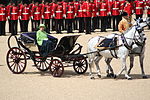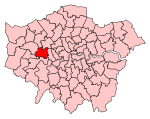Acton Town tube station

Acton Town is a London Underground station in the south-west corner of Acton, West London, in the London Borough of Ealing, close to the border with the London Borough of Hounslow. The station is served by the District and Piccadilly lines and is in Travelcard Zone 3. On the District line, it is between Chiswick Park and Ealing Common stations, and on the Piccadilly line it is between Hammersmith (Turnham Green in the early mornings and late evenings) and Ealing Common on the Uxbridge branch & South Ealing on the Heathrow branch. This was one of the oldest-running train stations in the world. Acton Town station was opened as Mill Hill Park on 1 July 1879 by the District Railway (DR, now the District line). It remained as a terminus until on 1 May 1883 and 23 June 1903 the DR opened two branches from Acton Town to Hounslow Town and Park Royal & Twyford Abbey respectively. On 4 July 1932 the Piccadilly line was extended to Acton Town. District line services to both the Hounslow and Uxbridge branches were withdrawn completely on 9 and 10 October 1964 after which operations were provided by the Piccadilly line alone. The original brick-built station was built in 1879 and in February 1910 the station building was reconstructed. On 1 March 1910 the station was given its present name. In 1931 and 1932 the station was rebuilt again in preparation for transferring the Uxbridge branch service from the District line to the Piccadilly line. The new station was designed by Charles Holden in a modern European geometric style using brick, reinforced concrete and glass.
Excerpt from the Wikipedia article Acton Town tube station (License: CC BY-SA 3.0, Authors, Images).Acton Town tube station
Gunnersbury Lane, London Acton (London Borough of Ealing)
Geographical coordinates (GPS) Address Nearby Places Show on map
Geographical coordinates (GPS)
| Latitude | Longitude |
|---|---|
| N 51.502777777778 ° | E -0.28 ° |
Address
Acton Town Station
Gunnersbury Lane
W3 8HN London, Acton (London Borough of Ealing)
England, United Kingdom
Open on Google Maps




